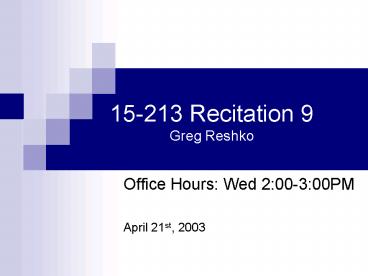15-213 Recitation 9 Greg Reshko - PowerPoint PPT Presentation
Title:
15-213 Recitation 9 Greg Reshko
Description:
Kernel maintains all information about files and just returns a file descriptor ... Use of mutex to lock resources glossed over for now. Reading to/from Network & File ... – PowerPoint PPT presentation
Number of Views:229
Avg rating:3.0/5.0
Title: 15-213 Recitation 9 Greg Reshko
1
15-213 Recitation 9Greg Reshko
- Office Hours Wed 200-300PM
- April 21st, 2003
2
Outline
- File I/O
- Networking
- Lab 7
3
Unix File I/O
- All I/O devices are modeled as files
- Networks, disks, terminals, etc
- All input and output is performed by reading and
writing the appropriate files - Kernel maintains all information about files and
just returns a file descriptor to an application
that wants access to a given file
4
Unix File I/O Read/Write
include ltunistd.hgt ssize_t read(int fd, void
buf, size_t count) ssize_t write(int fd, const
void buf, size_t count)
5
Unix File I/O More Robust
Robust I/O (RIO) Package Unbuffered ssize_t
readn(int fd, void buf, size_t count) ssize_t
writen(int fd, const void buf, size_t
count) ssize_t readline(int fd, void buf,
size_t maxlen) Buffered (thread-safe) ssize_t
readnb(int fd, void buf, size_t count) ssize_t
writenb(int fd, const void buf, size_t
count) ssize_t readlineb(int fd, void buf,
size_t maxlen)
6
Standard I/O vs. Unix I/O
- Standard I/O almost always preferred
- fopen, fclose, fseek, fread, fwrite, fscanf,
fprintf, etc. - A higher-level abstraction than UNIX I/O
- Models files as streams, like file descriptors in
being full-duplex - Restrictions exist that interact badly with
restrictions on sockets - Input function cannot follow an output function
(or vice versa) without a call to fflush, fseek,
fsetpos, rewind, or and end-of-file
7
Networking
- Two sides to networking
- Client / Server
- Distinction is fading
- Peer-to-peer systems mean a node is both
8
Client Code Path
- Clients typically connect to servers, perform a
task, then close the connection - Create a socket()
- Connect()
- Write()/read()
- Close()
9
Server Code Path
- Servers wait for connections and handle them as
they arrive - Create a socket()
- Bind() to a port
- Listen() for connections
- Select() a ready connection
- Accept() a connection
- Read()/Write()
- Close() the connection
- Well focus on TCP, but UDP is just as important
10
Server Init
- void CreateTCPServer()
- struct sockaddr_in myAddr
- int myAddrLen
- int reuseAddrFlg1
- tcpSocketfd socket(AF_INET,SOCK_STREAM,0)
- bzero((void )(myAddr),sizeof(myAddr))
- myAddr.sin_family AF_INET
- myAddr.sin_port htons((unsigned
short)atoi(chatTCPServerPort)) - myAddr.sin_addr.s_addr htonl(INADDR_ANY)
- setsockopt(tcpSocketfd,SOL_SOCKET,SO_REUSEADDR,(
void ) reuseAddrFlg,sizeof(reuseAddrFlg))
- bind(tcpSocketfd,(struct sockaddr
)myAddr,sizeof(myAddr)) - listen(tcpSocketfd,MAX_BACKLOG)
11
Server Loop
- while(1)
- readSetallSet
- numReadyDescriptorsselect(maxfd1,readSet,NUL
L,NULL,NULL) - if(FD_ISSET(tcpSocketfd,readSet))
- / Incoming request for new connection /
- struct sockaddr_in clientAddr
- int clientAddrLen
- slavefdaccept(tcpSocketfd,(struct sockaddr
) clientAddr, clientAddrLen) - / Save slavefd so we know to check it
later / - FD_SET(slavefd,allSet)
- if(slavefd gt maxfd) maxfdslavefd
- fflush(stdout)
- numReadyDescriptors--
- if(numReadyDescriptors lt 0)
- continue
12
Server The Rest
- Check whether interesting socket descriptors are
in the read/write set - Do appropriate action if they are (i.e., read()
or write()) - Close() the connection when appropriate
13
Logging and Network I/O
- Have a server set up to receive requests and
respond to them - Read in request, parse, and return response
- Need to read/write to a network stream, and log
events to a file for record-keeping purposes - Main loop opens file for logging and spawns
children threads - Each thread has own network streams, but shares
logging file stream - Use of mutex to lock resources glossed over for
now
14
Reading to/from Network File
- void main ()
- FILE log
- / open file /
- log fopen ( "log.txt, "a )
- while ( true )
- /
- Main Loop (inside thread)
- /
- fclose ( log )
15
Reading to/from Network File
- void thread ( void vargp )
- FILE stream
- char methodBUFSIZE, uriBUFSIZE,
versionBUFSIZE - / create mutex /
- / given argument, set file descriptor for
proper access to streams / - childfd ((int )vargp)
- free(vargp)
- / open file descriptors for reading network
socket, set buffer type / - if ((stream fdopen(childfd, "r")) NULL)
- error("ERROR on fdopen")
- setvbuf(stream, NULL, _IONBF, 0)
- / get header off the stream and save /
- fgets(buf, BUFSIZE, stream)
- sscanf(buf, "s s s\n", method, uri, version)
16
Reading to/from Network File
- /
- Parse, error check, ready for server
communication. - /
- /
- determine size of information to be written
back - in this case, copying from some other stream
(buf) - to the network stream (stream)
- /
- / get size of remaining buffer from stream /
- temp read ( serverfd, buf, BUFSIZE )
- while ( temp gt 0 )
- data.byte temp
- /
- write current buffered amount to
network socket - get size of remaining buffer from
stream - /
17
Reading to/from Network File
- / init mutex /
- / lock mutex /
- / write to log file /
- fprintf(log, "s s s d\n", data.date,
data.ip, data.address, data.byte) - / unlock mutex /
- / close network buffer /
- fclose(stream)
18
Lab 7 Logging Web Proxy
- Start early (yeah, thats a new one)
- Read the book carefully
- Everything you need for this lab is in the book
make sure you understand it - Concurrency issues
- Test it with your web browser
- i.e. Internet Explorer
- This is the coolest part of the lab













![⚡[PDF]✔ Greg Williams Photo Breakdowns: The Stories Behind 100 Portraits PowerPoint PPT Presentation](https://s3.amazonaws.com/images.powershow.com/10062873.th0.jpg?_=20240624073)

















